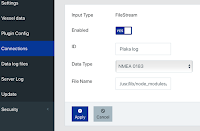Battery cables for cars & boats, DIY

At higher outputs, current, from the batteries I had detected an increasing voltage drop. So I decided to change and update the supply cables from the batteries, see picture, to a more correct solution. The solution was Cable lugs on all cables The lug is crimped and soldered to the cable Heat shrink tubes, with glue, to cover the transition between the lug and cable Battery terminals with M10 distributer











